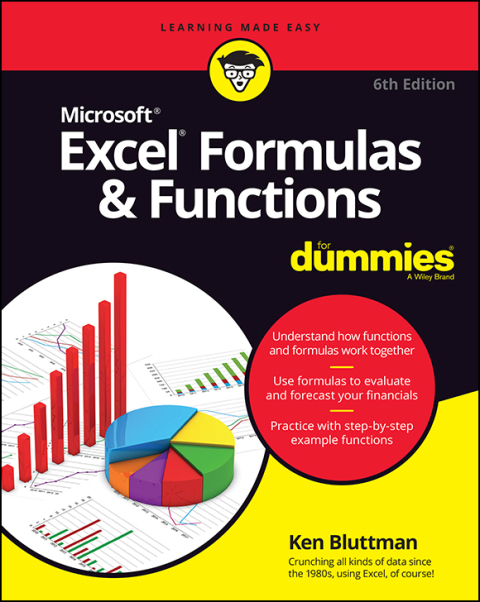Description
Efnisyfirlit
- Cover
- Title Page
- Copyright
- Introduction
- About This Book
- Foolish Assumptions
- Icons Used in This Book
- Beyond the Book
- Where to Go from Here
- Part 1: Getting Started with Excel Formulas and Functions
- Chapter 1: Tapping Into Formula and Function Fundamentals
- Working with Excel Fundamentals
- Gaining the Upper Hand on Formulas
- Using Functions in Formulas
- Chapter 2: Saving Time with Function Tools
- Getting Familiar with the Insert Function Dialog Box
- Finding the Correct Function
- Entering Functions Using the Insert Function Dialog Box
- Directly Entering Formulas and Functions
- Chapter 3: Saying “Array!” for Formulas and Functions
- Discovering Arrays
- Using Arrays in Formulas
- Working with Functions That Return Arrays
- Chapter 4: Fixing Formula Boo-Boos
- Catching Errors As You Enter Them
- Auditing Formulas
- Watching the Watch Window
- Evaluating and Checking Errors
- Making an Error Behave the Way You Want
- Part 2: Doing the Math
- Chapter 5: Calculating Loan Payments and Interest Rates
- Understanding How Excel Handles Money
- Figuring Loan Calculations
- Chapter 6: Appreciating What You’ll Get, Depreciating What You’ve Got
- Looking into the Future
- Depreciating the Finer Things in Life
- Measuring Your Internals
- Chapter 7: Using Basic Math Functions
- Adding It All Together with the SUM Function
- Rounding Out Your Knowledge
- Leaving All Decimals Behind with INT
- Leaving Some Decimals Behind with TRUNC
- Looking for a Sign
- Ignoring Signs
- Chapter 8: Advancing Your Math
- Using PI to Calculate Circumference and Diameter
- Generating and Using Random Numbers
- Ordering Items
- Combining
- Raising Numbers to New Heights
- Multiplying Multiple Numbers
- Using What Remains with the MOD Function
- Summing Things Up
- Getting an Angle on Trigonometry
- Part 3: Solving with Statistics
- Chapter 9: Throwing Statistics a Curve
- Getting Stuck in the Middle with AVERAGE, MEDIAN, and MODE
- Deviating from the Middle
- Analyzing Data with Percentiles and Bins
- Going for the Count
- Chapter 10: Using Significance Tests
- Testing to the T
- Comparing Results with an Estimate
- Chapter 11: Rolling the Dice on Predictions and Probability
- Modeling
- Getting It Straight: Using SLOPE and INTERCEPT to Describe Linear Data
- What’s Ahead: Using FORECAST, TREND, and GROWTH to Make Predictions
- Using NORM.DIST and POISSON.DIST to Determine Probabilities
- Part 4: Dancing with Data
- Chapter 12: Dressing Up for Date Functions
- Understanding How Excel Handles Dates
- Formatting Dates
- Making a Date with DATE
- Breaking a Date with DAY, MONTH, and YEAR
- Converting a Date from Text
- Finding Out What TODAY Is
- Determining the Day of the Week
- Working with Workdays
- Calculating Time Between Two Dates with the DATEDIF Function
- Chapter 13: Keeping Well-Timed Functions
- Understanding How Excel Handles Time
- Formatting Time
- Keeping TIME
- Converting Text to Time with TIMEVALUE
- Deconstructing Time with HOUR, MINUTE, and SECOND
- Finding the Time NOW
- Calculating Elapsed Time Over Days
- Chapter 14: Using Lookup, Logical, and Reference Functions
- Testing on One Condition
- Choosing the Right Value
- Let’s Be Logical
- Finding Where the Data Is
- Looking It Up
- Chapter 15: Digging Up the Facts
- Getting Informed with the CELL Function
- Getting Information About Excel and Your Computer System
- Finding What IS and What IS Not
- Getting to Know Your Type
- Chapter 16: Writing Home about Text Functions
- Breaking Apart Text
- Putting Text Together with CONCATENATE
- Changing Text
- Comparing, Finding, and Measuring Text
- Chapter 17: Playing Records with Database Functions
- Putting Your Data into a Database Structure
- Working with Database Functions
- Fine-Tuning Criteria with AND and OR
- Adding Only What Matters with DSUM
- Going for the Middle with DAVERAGE
- Counting Only What Matters with DCOUNT
- Finding Highest and Lowest with DMIN and DMAX
- Finding Duplicate Values with DGET
- Being Productive with DPRODUCT
- Part 5: The Part of Tens
- Chapter 18: Ten Tips for Working with Formulas
- Master Operator Precedence
- Display Formulas
- Fix Formulas
- Use Absolute References
- Turn Calc On/Turn Calc Off
- Use Named Areas
- Use Formula Auditing
- Use Conditional Formatting
- Use Data Validation
- Create Your Own Functions
- Chapter 19: Ten Ways to Get Fancy with Excel
- Calculating Data from Multiple Sheets
- Getting Data from the Internet
- Determining the Needed Number
- Removing Duplicates
- Getting to the Last Row of Your Data
- Freezing Panes
- Splitting a Worksheet
- Filling Cells
- Adding Notes to Cells
- Getting More Information about a Workbook or Worksheet
- Chapter 20: Ten Really Cool Functions
- Work with Hexadecimal, Octal, Decimal, and Binary Numbers
- Convert Units of Measurement
- Find the Greatest Common Divisor and the Least Common Multiple
- Easily Generate a Random Number
- Convert to Roman Numerals
- Factor in a Factorial
- Determine Part of a Year with YEARFRAC
- Find the Data TYPE
- Find the LENgth of Your Text
- Just in CASE
- Index
- About the Author
- Advertisement Page
- Connect with Dummies
- End User License Agreement






Reviews
There are no reviews yet.